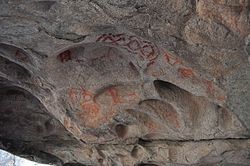| El Vallecito Archaeological Site – Kumeyaay Culture | ||
 | ||
 | ||
| Name: | El Vallecito | |
| Type | Mesoamerican archaeology | |
| Location | La Rumorosa, Tecate Municipality, Baja California | |
| Region | Aridoamerica | |
| Coordinates | 32°31′0″N 116°14′53″W / 32.51667°N 116.24806°W | |
| Culture | Kumeyaay (Spanish:Kumiai) | |
| Language | Kumeyaay | |
| Chronology | 1000 BCE | |
| Period | Prehistory | |
| INAH Web Page | El Vallecito, INAH Web Page | |
El Vallecito is an archaeological site located in the city of La Rumorosa,[1] in the Tecate Municipality, Baja California, Mexico.
It is believed that Baja California had human presence for thousands of years, however the available evidence indicates an occupation approximate from 8000 BCE. Some sites are more recent, it is estimated that they were developed in the last thousand years, though the engravings, more resistant to erosion, could be older.[2]
The site was inhabited by the Kumeyaay ethnic group whose territory comprised from Santo Tomas, Baja California, to the San Diego coast in California. The eastern region ranged from the Escondido, California, area up to the mountains and deserts in northern Baja California, including the area of Laguna Salada and part of the sierra Juarez known as La Rumorosa.[1]
This site has more than 18 sets of cave painting of which only six may be visited.[1]
The Vallecito is considered one of the most important of the region. There are several important archaeological zones; however, officially not yet been appointed by the responsible authorities.[1]
The site has many cave paintings or petroglyphs made by the ancient peninsula inhabitants. It is known that the territory was occupied by nomadic groups who lived in the region and that they based their existence in hunting and the harvesting of fruits, seeds, roots and sea food.[1]
The decorated rocks with white, black and red figures are pictures made approximately three thousand years ago, when various migratory flows penetrated the Baja California region, known as Yuman or Quechan, which came from what is now the United States.[1]
- ^ a b c d e f "Pagina INAH el sitio El vallecito" [El Vallecito, site web page]. INAH (in Spanish). Mexico. Archived from the original on 2010-09-10.
- ^ "El Vallecito, Pinturas Rupestres" [El Vallecito, cave paintings] (in Spanish). Pueblos de Mexico.